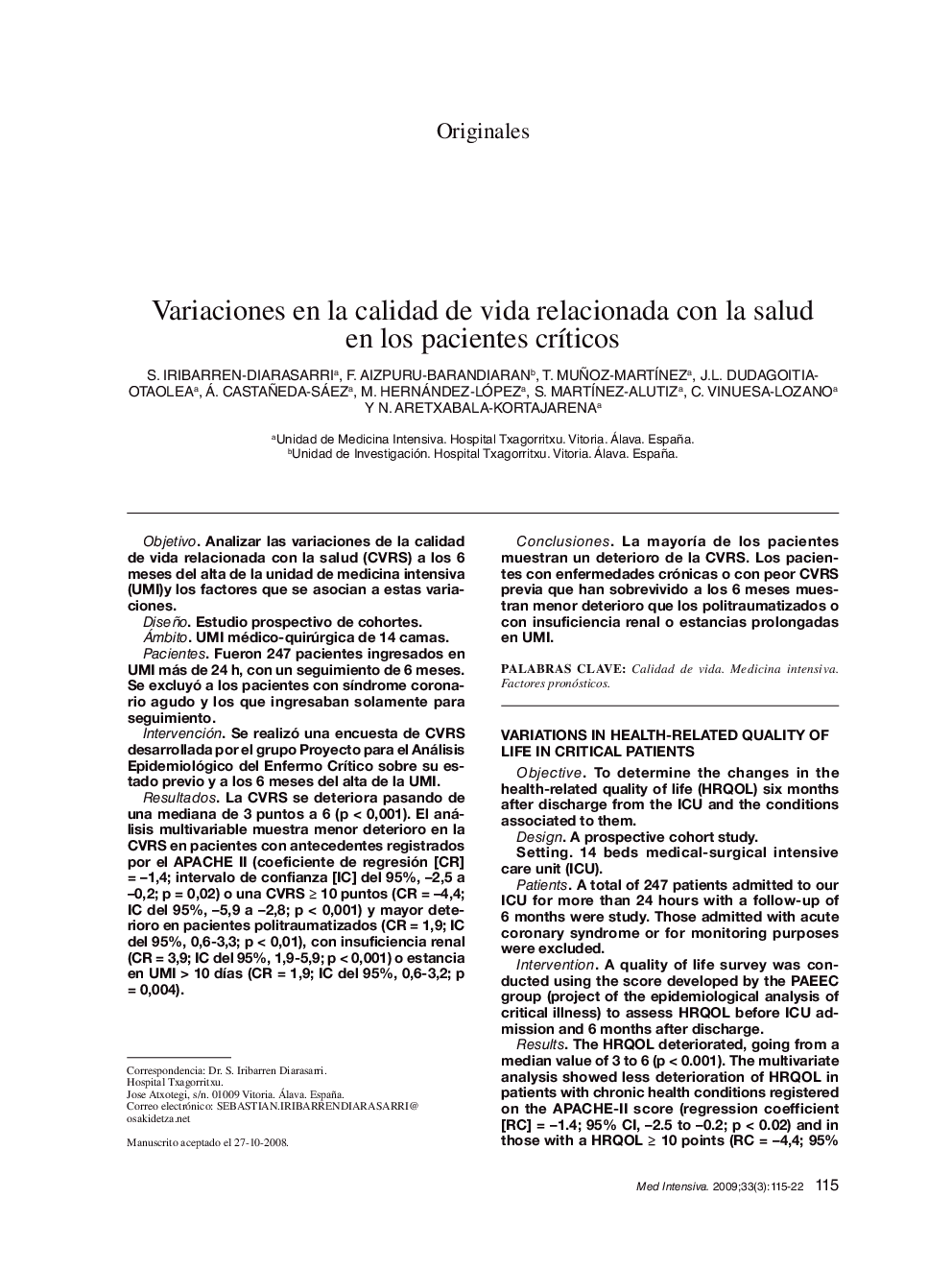| Article ID | Journal | Published Year | Pages | File Type |
|---|---|---|---|---|
| 3113378 | Medicina Intensiva | 2009 | 8 Pages |
ObjetivoAnalizar las variaciones de la calidad de vida relacionada con la salud (CVRS) a los 6 meses del alta de la unidad de medicina intensiva (UMI)y los factores que se asocian a estas variaciones.DiseñoEstudio prospectivo de cohortes.ÁmbitoUMI médico-quirúrgica de 14 camas.PacientesFueron 247 pacientes ingresados en UMI más de 24 h, con un seguimiento de 6 meses. Se excluyó a los pacientes con síndrome coronario agudo y los que ingresaban solamente para seguimiento.IntervenciónSe realizó una encuesta de CVRS desarrollada por el grupo Proyecto para el Análisis Epidemiológico del Enfermo Crítico sobre su estado previo y a los 6 meses del alta de la UMI.ResultadosLa CVRS se deteriora pasando de una mediana de 3 puntos a 6 (p < 0,001). El análisis multivariable muestra menor deterioro en la CVRS en pacientes con antecedentes registrados por el APACHE II (coeficiente de regresión [CR] = −1,4; intervalo de confianza [IC] del 95%, −2,5 a −0,2; p = 0,02) o una CVRS ≥ 10 puntos (CR = −4,4; IC del 95%, −5,9 a −2,8; p < 0,001) y mayor deterioro en pacientes politraumatizados (CR = 1,9; IC del 95%, 0,6-3,3; p < 0,01), con insuficiencia renal (CR = 3,9; IC del 95%, 1,9-5,9; p < 0,001) o estancia en UMI > 10 días (CR = 1,9; IC del 95%, 0,6-3,2; p = 0,004).ConclusionesLa mayoría de los pacientes muestran un deterioro de la CVRS. Los pacientes con enfermedades crónicas o con peor CVRS previa que han sobrevivido a los 6 meses muestran menor deterioro que los politraumatizados o con insuficiencia renal o estancias prolongadas en UMI.
ObjectiveTo determine the changes in the health-related quality of life (HRQOL) six months after discharge from the ICU and the conditions associated to them.DesignA prospective cohort study.Setting14 beds medical-surgical intensive care unit (ICU).PatientsA total of 247 patients admitted to our ICU for more than 24 hours with a follow-up of 6 months were study. Those admitted with acute coronary syndrome or for monitoring purposes were excluded.InterventionA quality of life survey was conducted using the score developed by the PAEEC group (project of the epidemiological analysis of critical illness) to assess HRQOL before ICU admission and 6 months after discharge.ResultsThe HRQOL deteriorated, going from a median value of 3 to 6 (p < 0.001). The multivariate analysis showed less deterioration of HRQOL in patients with chronic health conditions registered on the APACHE-II score (regression coefficient [RC] = −1.4; 95% CI, −2.5 to −0.2; p < 0.02) and in those with a HRQOL ≥ 10 points (RC = −4,4; 95% CI, −5.9 to −2.8; p < 0.001). There was more deterioration in polytraumatized patients (RC = 1.9; 95% CI, 0.6-3.3; p = 0.01) or with renal failure (RC = 3.9; 95% CI, 1.9-5.9; p < 0.001) or in those with a stay duration longer than 10 days (RC = 1.9; 95% CI, 0.6-3.2; p < 0.001).ConclusionsMost patients experience deterioration of HRQOL. Patients with chronic diseases or with worst previous HRQOL who survive 6 months experience less deterioration of HRQOL than those who are polytraumatized or have renal failure or a longer ICU stay.
